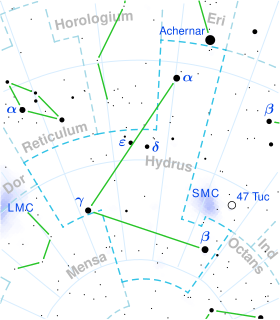Zeta Hydri
| Observation data Epoch J2000 Equinox J2000 | |
|---|---|
| Constellation | Hydrus |
| Right ascension | 02h 45m 32.63435s[1] |
| Declination | −67° 36′ 59.8268″[1] |
| Apparent magnitude (V) | 4.83[2] |
| Characteristics | |
| Spectral type | A2IV[2] |
| U−B color index | +0.09[3] |
| B−V color index | +0.06[3] |
| Astrometry | |
| Radial velocity (Rv) | +3.60[4] km/s |
| Proper motion (μ) | RA: +66.41[1] mas/yr Dec.: +43.38[1] mas/yr |
| Parallax (π) | 11.47 ± 0.17 mas[1] |
| Distance | 284 ± 4 ly (87 ± 1 pc) |
| Absolute magnitude (MV) | 0.13[2] |
| Details | |
| Mass | 2.44[5] M☉ |
| Radius | 3.9[5] R☉ |
| Luminosity | 79.55[2] L☉ |
| Surface gravity (log g) | 3.72[6] cgs |
| Temperature | 9,144[6] K |
| Rotational velocity (v sin i) | 116[6] km/s |
| Other designations | |
| Database references | |
| SIMBAD | data |
Zeta Hydri, Latinized from ζ Hydri, is a single,[7] white-hued star in the southern constellation of Hydrus. It is faintly visible to the naked eye with an apparent magnitude of 4.83.[2] This distance to this star can be estimated from its annual parallax shift of 11.47 mas,[1] showing it to be about 284 light years away. It is moving further away from the Sun with a radial velocity of +3.6 km/s.[4]
The spectrum of this star matches a stellar classification of A2 IV,[2] suggesting it is a subgiant star that is in the process of evolving away from the main sequence as the supply of hydrogen at its core becomes exhausted. It has a high rate of spin, showing a projected rotational velocity of 116 km/s.[6] This is giving the star a slight oblate shape with an equatorial bulge that is 5% larger than the polar radius.[8] It has 2.4 times the mass of the Sun and nearly four times the Sun's radius.[5] Zeta Hydri is radiating 80[2] times the Sun's luminosity into space from its photosphere at an effective temperature of 9,144 K.[6]
References
- ^ a b c d e f Van Leeuwen, F. (2007). "Validation of the new Hipparcos reduction". Astronomy and Astrophysics. 474 (2): 653–664. arXiv:0708.1752. Bibcode:2007A&A...474..653V. doi:10.1051/0004-6361:20078357. S2CID 18759600. Vizier catalog entry
- ^ a b c d e f g Anderson, E.; Francis, Ch. (2012). "XHIP: An extended hipparcos compilation". Astronomy Letters. 38 (5): 331. arXiv:1108.4971. Bibcode:2012AstL...38..331A. doi:10.1134/S1063773712050015. S2CID 119257644. Vizier catalog entry
- ^ a b Mallama, A. (2014). "Sloan Magnitudes for the Brightest Stars". The Journal of the American Association of Variable Star Observers. 42 (2): 443. Bibcode:2014JAVSO..42..443M.Vizier catalog entry
- ^ a b Wilson, R. E. (1953). "General Catalogue of Stellar Radial Velocities". Carnegie Institute Washington D.C. Publication. Carnegie Institution of Washington. Bibcode:1953GCRV..C......0W. LCCN 54001336.
- ^ a b c Allende Prieto, C.; Lambert, D. L. (1999). "Fundamental parameters of nearby stars from the comparison with evolutionary calculations: Masses, radii and effective temperatures". Astronomy and Astrophysics. 352: 555–562. arXiv:astro-ph/9911002. Bibcode:1999A&A...352..555A. Vizier catalog entry
- ^ a b c d e David, Trevor J.; Hillenbrand, Lynne A. (2015). "The Ages of Early-Type Stars: Strömgren Photometric Methods Calibrated, Validated, Tested, and Applied to Hosts and Prospective Hosts of Directly Imaged Exoplanets". The Astrophysical Journal. 804 (2): 146. arXiv:1501.03154. Bibcode:2015ApJ...804..146D. doi:10.1088/0004-637X/804/2/146. S2CID 33401607. Vizier catalog entry
- ^ Eggleton, P. P.; Tokovinin, A. A. (September 2008), "A catalogue of multiplicity among bright stellar systems", Monthly Notices of the Royal Astronomical Society, 389 (2): 869–879, arXiv:0806.2878, Bibcode:2008MNRAS.389..869E, doi:10.1111/j.1365-2966.2008.13596.x, S2CID 14878976.
- ^ Belle, G. T. (2012). "Interferometric observations of rapidly rotating stars". The Astronomy and Astrophysics Review. 20 (1): 51. arXiv:1204.2572. Bibcode:2012A&ARv..20...51V. doi:10.1007/s00159-012-0051-2. S2CID 119273474.

